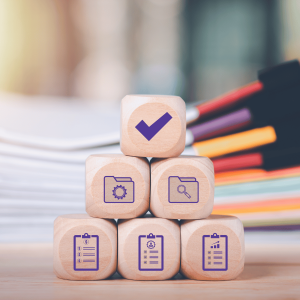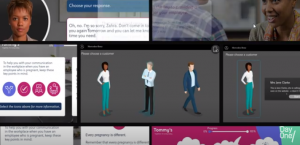As we move into 2024, we are anticipating further transformative shifts that will shape the learning landscape, in part based on the convergence of technology, evolving learner needs, and an increasingly dynamic business environment that we witnessed last year.
These factors have given rise to a series of trends that we believe will continue to influence how we approach learning and keep the focus on the learner.
In this blog post we break down these trends in more detail.

1. Personalised Learning: Tailoring Experiences to Each Learner
Recognising the unique learning preferences, and needs of individual learners has become an important part of a learning programme. AI-powered adaptive learning platforms are gaining traction, dynamically adjusting content and assessments based on each learner’s progress.
This personalised approach ensures that learners receive the most relevant and engaging content, maximizing their learning outcomes.
In fact, according to a recent survey in CIPD’s Professionalising Learning and Development report, it found that 98% of employees feel that personalisation would improve their learning experience.
Personalised learning is not just a buzzword; it’s a proven approach that can significantly impact employee learning outcomes. When learners are provided with content and instruction that is tailored to their individual needs, they are more likely to be engaged, motivated, and successful in their learning journeys.
2. Immersive Experiences: Enhancing Learning with Virtual Reality and Augmented Reality
Immersive learning technologies, such as VR and AR, are breaking down the barriers between the digital and physical worlds, creating captivating and interactive learning experiences. VR simulations allow learners to step into virtual environments, engaging with complex scenarios and gaining hands-on experience in a safe and controlled setting. AR overlays digital elements onto the real world, enhancing existing learning materials with interactive elements and contextual learning opportunities.
Research supports the effectiveness of VR in enhancing training for leadership, soft skills and other human to human interactions. A study by PWC to show how effective virtual reality is to train people showed that 40% of the VR learners saw an improvement in their confidence compared to those who did their learning in a traditional classroom environment. They completed their training 4 times faster also.
3. Microlearning: Bite-sized Learning for Just-in Time Knowledge
In today’s fast-paced business world, learners demand bite-sized learning solutions that fit conveniently into their busy schedules.
Microlearning, with its concise and focused content, addresses this need by delivering small, modular learning units that can be consumed in minutes. This approach allows learners to acquire new skills and knowledge at their own pace, making it ideal for just-in-time learning and skill refreshers.
Microlearning offers several benefits that make it an attractive option for organisations seeking to enhance employee learning and development:
- Convenience: Microlearning modules can be accessed anytime, anywhere, on any device, making them highly convenient for learners with busy schedules.
- Engagement: Short, focused modules can capture and maintain learner attention, leading to better engagement and overall motivation.
- Retention: Microlearning’s bite-sized format helps learners retain information more effectively, as it breaks down complex topics into manageable chunks.
- Just-In-Time Learning: Microlearning is ideal for just-in-time learning, providing learners with the knowledge they need to address specific challenges or tasks at hand.
- Upskilling and Refreshing Skills: Microlearning modules are well-suited for upskilling and refreshing skills, ensuring that employees stay current with emerging trends and technologies.
The Digital Learning Institute states that there is a 50% higher engagement rate when microlearning is used and that learners have a better retention rate. This shows the big impact microlearning can have on your learners.
4. Gamification: Adding Fun and Engagement to Learning.
Gamification has proven to be a powerful tool for enhancing engagement and motivation in learning. By incorporating game-like elements such as points, leaderboards, and challenges, gamification transforms learning into an enjoyable and rewarding experience. This approach can effectively capture learner attention, making learning more active and participatory.
Gamification offers several advantages that make it a valuable tool for enhancing employee learning and development:
- Increased Engagement: Gamification captures and maintains learner attention, making learning more active and participatory.
- Motivation: Game-like elements provide learners with a sense of achievement and progress, keeping them motivated and engaged in the learning process.
- Knowledge Retention: Gamification can enhance knowledge retention by associating learning material with enjoyable and rewarding experiences.
- Skill Acquisition: Gamification can effectively facilitate skill acquisition by providing learners with opportunities to practice and apply their knowledge in a simulated environment.
A survey from the School of Electrical and Computer Engineering at the National Technical University of Athens, Greece, involving 365 students, revealed that challenge-based gamification could boost student performance by 89.45% compared to traditional lecture-based methods.
5. Blended Learning: Combining Traditional and Digital Approaches
The traditional classroom setting is still relevant, but it’s no longer the sole delivery method of learning. Blended learning strategies combine traditional classroom instruction with digital learning tools, creating a hybrid approach that caters to diverse learning preferences.
This blend ensures that learners receive personalised support, while also providing opportunities for collaborative learning and knowledge exchange. It has also shown that employee engagement and knowledge retention is improved with this method.
This is shown in the CIPD Learning and Development Report 2023. 74% of respondents agreed that blended learning leads to higher employee engagement in learning than traditional methods.
The Brandon Hall Group 2023 Skills and Workforce Development Study found that employees who receive blended learning report 30% higher knowledge retention compared to those who receive only traditional or only online learning.
In Summary
Organisations that embrace these approaches will be well-positioned to equip their employees with the skills and knowledge they need to thrive in an ever-changing world.

By leveraging technology, personalised learning, immersive experiences, microlearning, gamification, and blended learning strategies, organisations can create engaging, effective, and scalable learning programs that empower their employees to achieve their full potential.


















